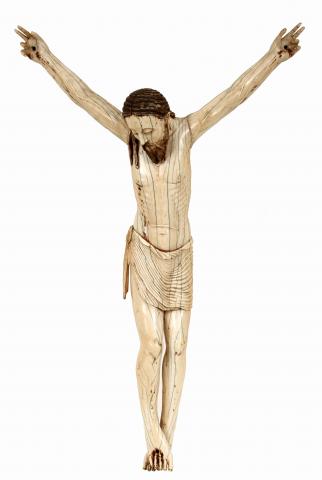Jesus Cristo
Jesus Cristo
Marfim
Cíngalo -português, séc. XVI / XVII
Alt.: 67,0 cm
Prov.: Coleção Particular, Évora
Jesus Christ
Ivory
Sinhalese-Portuguese
Late 16th – early 17th century
H.: 67.0 cm
Prov.: P.C., Évora
Exquisite 16th – 17th century Sinhalese-Portuguese sculpture of unusual size and exceptional artistic quality. The crucified Christ is defined by a large oval serene face and finely grooved hair with a large tress falling over his right shoulder.
The eyes are almond shaped, almost Chinese like, the nose fine and delicate, the mouth small and framed by a long tipped moustache and forked curly hair. The extraordinary realism of
anatomical details is evidenced by the careful depiction of the pronounced ribs and blood vessels, muscular groups and skin folds. Of note also are the delicate hands and feet and the long, elegant fingers and toes. The unassuming lention, tied on the right hand side, is typically Ceylonese in the simplicity of the parallel folds that define it.
Albeit, by its characteristics, undoubtedly of Ceylonese manufacture the specific details of this piece as described above suggest that it might have been the work of a Chinese craftsman working in Ceylon.
The artistic quality of Ceylonese sculpture ensured the success and reputation the local workshops enjoyed, reinforced by the Island role as an important and strategic trading post, and the constant demands, throughout the long period of Portuguese influence, of a public avid for exotic artifacts in the new, hybrid styles that crossed traditional Ceylonese concepts
and details with European typologies.
Sinhalese-Portuguese ivories remain the most admirable and delicate of all produced in Asia throughout the 16th and 17th centuries, their character clearly distinct from other productions; the carving is normally more precise and detailed than in contemporary Indo-Portuguese pieces, the eyes almond‑shaped with crescent cut brow, the nose is fine and delicate and the small mouth conveying a sense of calm and introspection.
Less relevant, the Portuguese impact in China was geographically restricted to small areas of influence surrounding each one of the various trading factories established along the coast. Highly skilled artists, the Southern Chinese produced high quality ivory pieces, drawing from their own aesthetic and artistic references and spirituality, following typically local conventional details such as semi-open mouths and large almond‑shaped eyes.
Bela escultura de rara dimensão e qualidade, com grande minúcia de entalhe, cíngalo‑portuguesa do séc. XVI / XVII.
Jesus Cristo apresenta um rosto grande, ovalado e sereno, com cabelos desenhando estrias muito finas e uma madeixa pendente sobre a direita. Olhos amendoados e achinesados, nariz fino, boca pequena, grande bigode pendente e barba bifurcada em madeixas enroladas.
De corpo desnudo, esta peça surpreende pelo grande rigor e realismo anatómico, patente não só na elegância dos arcos costais e dos vasos sanguíneos, mas também no desenho dos diferentes grupos musculares e das pregas cutâneas. Realçamos ainda as mãos e pés de fino entalhe, com dedos longos e delicados.
Apresenta um belo e singelo cendal, em finas pregas paralelas, indumentária típica nos marfins do Ceilão.
As características são facilmente identificáveis como exemplo notável de Jesus Cristo crucificado de origem cingalesa, pese embora a expressão, os olhos achinesados e o tipo de bigode nos façam pensar nas esculturas sino‑portuguesas, o que nos leva a por a hipótese de se tratar com grande probabilidade de um exemplar executado no Ceilão por um artífice chinês imigrado.
A excelência artística da escultura do Ceilão conferiu grande fama às oficinas locais, com um prestígio reconhecido, para o qual contribuiu o papel histórico da ilha como feitoria comercial.
As oficinas de marfim proliferaram durante todo o período de influência portuguesa dando origem a um novo estilo, hibrido, que combinava formas e motivos tradicionais cingaleses com os que se inspiravam em gravuras e esculturas europeias.
Os marfins cíngalo-portugueses encontram‑se entre os mais admiráveis e delicados de todos os que foram produzidos na Ásia. As características são facilmente identificáveis; o entalhe é normalmente mais preciso e nítido do que nas peças homólogas indo‑portuguesas, com olhos amendoados, sobrancelhas recortadas em forma de quarto crescente, nariz fino, boca pequena, transmitindo uma atitude de calma e meditação.
Menos preponderante foi a influência religiosa dos portugueses na China, onde a acção missionária apenas se limitou a uma pequena parcela para além da área de cada uma das feitorias estabelecidas ao longo da costa chinesa. Hábeis artistas, os chineses do sul, produziram peças de grande qualidade, com características próprias, com rostos geralmente muito expressivos denotando espiritualidade e misticismo. A fisionomia e expressão são nitidamente “achinesadas”, com a boca entreaberta e os olhos grandes, oblongos e amendoados, revelando a preciosidade e o detalhe característicos da arte chinesa.
- Arte Colonial e Oriental
- Arte Cristã
- Marfins

